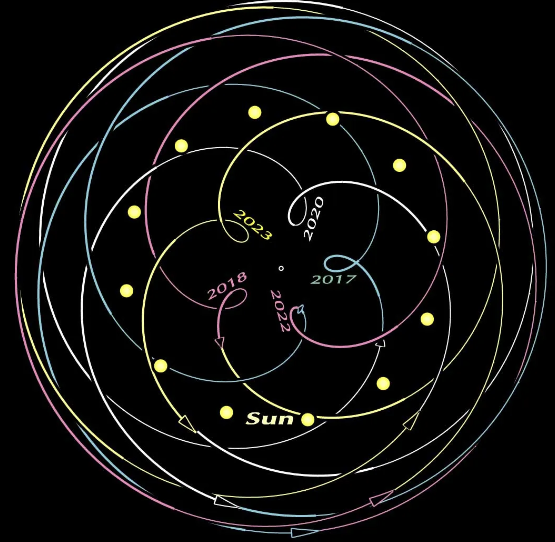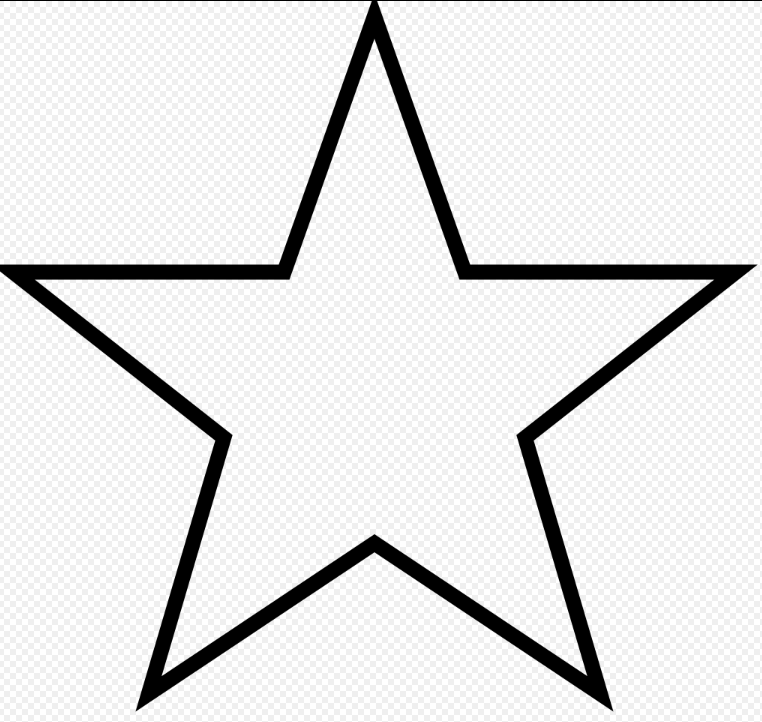Understanding the Orbit of Venus
and the appeal of Venus Star Points
Being able to increasingly comprehend the cosmos
is the work of many disconnected sectors
but astrologers can advantageously pursue
the naturally wholistic path and gain immensely
from the crossover with various fields
- most obviously astronomy
The standard positional astronomy graphic overhead view with added colour clarification shows the 2 different conjunction positions possible for an inner planet [Mercury or Venus]
Venus at superior conjunction is on the far side of the Sun and hidden from Earth view.
We only get up close and personal when she is near Earth and especially when retrograde and at the inferior conjunction with Earth and Sun
Venus is famous for beauty and loves floristry so it is perfectly appropriate that in fulfilling this planet’s orbital pattern in relationship to Earth and Sun that a 5-petal flower pattern is formed.
Universal Workshop.com [which intentionally does not detail the full 8 year cycle] shows:
5 Venus-Sun inferior conjunctions within the standard 8 year cycle when Venus at the dated loops is retrograde and closest to the perspective from Earth [tiny yellow dot in the centre]
Although much of the complexity of pathways of Venus over 8 years has been excluded in graphic [a] it still allows the Venus 5 petals to be identified - especially when further erasure is applied by this author in graphic [b]
Planetary orbital directions are always anticlockwise
in graphic representations
After Venus completes the retrograde loop the orbit goes beyond the yellow dot Sun symbols and is out of sight of Earth when reaching exact superior conjunction with the Sun
Compare the above with [c]
[c] graphic Original sourced from Nicola Scafetta
The Complex Planetary Synchronization Structure of the Solar System
Although circular versus elliptical orbits are the standard graphic display device the example [c] above from solar scientist Nicola Scafetta is inherently astronomically accurate in depicting the orbit of Venus conforming to an interior square in relationship to the orbit of Earth.
This proportional relationship of Earth orbit to Venus orbit
is key to the creation of the famous 5-petal pattern
but timing and spatial positioning all together
serve to reinforce the quality of cosmic harmony
of the spheres within our local solar system
The orbit of Venus happens to be the most circular of any planet
In graphic [c] above Venus [red dot] orbits between Earth and Sun in anticlockwise orbital motion but the conjunction points are located distinctly differently in spatial positioning at each occurrence within the 8 year cycle period.
Venus is termed retrograde when conjunct Earth and at inferior conjunction with the Sun.
When getting to the essence of the Venus-Earth-Sun dynamics the 5-petal Star of Venus is more informative than the standard star symbol.
The hand-drawn fluoro pink trace added to Scafetta's graphic allows an alternate view of the Venus Star to be revealed step by step.
Being a time-based pattern the 5-petal star energetic field travels from one alignment point to the next chronologically in sequence.
This shows that despite the paths of Venus and Earth being standard closed loop orbits when conceived on a flat plane their orbital inter-relationship weaves an invisible energetic trace in 3D space
This trace also depicts the transit of Venus both in inferior retrograde conjunction and in superior conjunction to the Sun at the centre - 9.5 months after the inferior conjunction alignment which is shown on the standard orbital ring.
The complete story involves 3 players.
Factoring in Earth as a fully fledged functional planet is essential to our full comprehension of the solar system.
Without Earth to dance with the Venus pattern would not exist
John Martineau's handy reference to cosmic pattern-making shows the Venus-Earth pattern created over a full 8 year cycle
Explanatory notes on Scafetta graphic [c] above:
The 5 conjunction points start at 2012 then terminate at 2020:
Using Scafetta’s astronomical positioning of Venus at the 2012 2014 2015 2017 2018 inferior conjunctions with Sun and Earth - to see how the 5-petal star evolves -
follow the fluoro pink trace from Venus point 2012 bottom left up to 2014 top left then to 2015 bottom right then to 2017 left side and 2018 upper right -completing from there to 2020 bottom left - the start of the new cycle
Although the flower pattern is very intriguing it is important to go beyond the pretty picture and consider the meaningful qualities being evoked.
We can only wonder at the informational field being carried through sequentially from one Venus-Earth Sun alignment [imprint] to the next and this is where Venus Star Points are likely to provide answers.
Venus Star Points
Being able to understand the significance of key transits of Venus - our comparatively very close neighbouring planet may become even more important at it is reported to be coming even closer
The astronomy of planetary orbits especially the graphic representations enables a much clearer view of the special field of enquiry known as Venus Star Points - explored in great detail by Arielle Guttman after she received deep insights about Venus from the cosmos in 2004.
Arielle says of Venus: Her Star or Pentagram, is the Cosmic Heart Beat of the Earth and its inhabitants.
Check out the large body of work by Arielle to delve deeply into the modern era appreciation and understanding of Venus - work that has been rated significantly within the astrological world.
A lot of astrologers have embraced Arielle’s work - and eventually [since my scope has been intensely focussed elsewhere] - this work has permeated through to me - approaching it as a beginner testing the waters but intrigued to know more.
There is a lot to it but here are some basics to keep in mind
Kelly Surtees 2020 post on Venus retrograde mentions that the Venus Star points typically locate long-term in their grouping of 5 signs - this means when Arielle Guttman uses the standard graphic for this era as shown [d] above - the 5 signs are Gemini Capricorn Leo Aries Scorpio - but we know that ultimately there is a locational shift - and in 2022 the Scorpio point shifts back into Libra - 29 degrees on October 22 -which is being heralded as a globally significant energy shift towards sorting out all the facets of Libra - especially relationship dynamics and specifically the concept of partnership - from the personal to professional and on the larger collective scale.
What is partnership? What kind of partnership relationship do we want or need? What behaviours are required? What behaviours are deal-breakers?
In terms of Venus archetypes it looks like female/feminine power is really on the upswing! I think you can tell that collectively we have been fusing into this era for a few years in the waxing period before this October 2022 Sun Venus-Earth conjunction.
[only October 2026 sees a Venus Star Point resume early in Scorpio -otherwise it's Libra fully in the mix]
In my home country New Zealand the nation is hosting a 12 team international Women’s Rugby World Cup from 8 October-12 November 2022 including 3 important matches on Venus Day Saturday October 22.
This is proving to be a very popular sporting event appealing across the traditional gender boundaries - and the build up in excitement is to some extent eclipsing the famous local men’s rugby team the All Blacks.
We can rely on Arielle to fill in the juicy details on this shift into Venus being in her own sign Libra
Julija Simas of the Cosmic Intelligence Agency in a recent video presentation provides some helpful graphic representations of the Star Point dates in this video along with lots of detail explored with Arielle.
- Uranus in Taurus through 2022
- 2 Taurus eclipses
- North Node fully in Taurus for 346 days
- Uranus on North Node August
- Venus conjunct the October Scorpio solar eclipse
- Venus semisextile Uranus at the May Scorpio lunar eclipse
- Pluto opposite Venus - August
- Sun-Venus conjunction significantly at 29 Libra
- Pluto square Venus & Sun in Libra -October
- Venus opposite Uranus at November eclipse
- 2022 ends with Venus about to conjunct Pluto
- Within-text links are inserted re illustrative source material
- Scafetta,Nicola The Complex Planetary Synchronization Structure of the Solar System Pattern Recogn. Phys., 2, 1–19, 2014













No comments:
Post a Comment